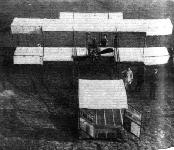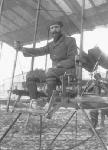
Farman I/II/III
<...>
В 1909 году Анри Фарман решил сам заняться проектированием самолетов вместе со своим братом Морисом, основав в Бийанкуре фирму "Avions Henri et Maurice Farman", в том же году приступившую к выпуску классического самолета Farman III. Эта машина имела один установленный впереди руль высоты и четыре элерона для управления по крену. От "завес" на крыле и горизонтальном оперении отказались, установили сдвоенные рули направления, облегченное четырехколесное шасси и ввели лыжи, предотвращавшие капотирование на неровной поверхности. В первом полете, состоявшемся в апреле 1909 года, Farman III был оснащен 4-цилиндровым рядным двигателем Vivinus мощностью 50 л. с. (37 кВт), который вскоре заменили новым 7-цилиндровым ротативным двигателем Gnome такой же мощности. На этом самолете Анри Фарман установил в 1909 году два мировых рекорда дальности полета. Первый рекордный результат был показан во время знаменитой встречи авиаторов в Реймсе, проходившей с 22 по 29 августа 1909 года, когда Фарман преодолел 180 км за 3 ч 5 мин. Второй рекорд был установлен в Мурмелоне 4 ноября 1909 года и составил 234,21 км. Так всего за два года Анри Фарман завоевал себе место в истории авиации.
ТАКТИКО-ТЕХНИЧЕСКИЕ ХАРАКТЕРИСТИКИ
Farman III (образца 1909 года)
Тип: одноместный биплан
Силовая установка: один 7-цилиндровый ротативный двигатель Gnome мощностью 50 л. с. (37 кВт)
Летные характеристики: максимальная скорость 60 км/ч
Масса: максимальная взлетная 550 кг
Размеры: размах крыла 10,00 м; длина 12,00 м; высота 3,50 м; площадь крыльев 40,00 м2
- Описание
Фотографии
-
История Авиации 2002-04 / С.Корж - Коммерческая авиация /Ретроспектива/ (3)
"Генри Фарман III" в музее.
-
Мировая Авиация 126
Farman III по-настоящему позволял почувствовать полет, благодаря своей продуманной конструкции с большими несущими поверхностями, элеронами вместо "завес" и легким, но прочным шасси.
-
OS 1 / H.Cowin - X-Planes
The first of Henry Farman's own designs, the Henry Farman III, with its 50hp Vivinus engine, made its maiden flight during April 1909, and soon consolidated Farman among the front rank of French aviators. For the record, Henry Farman's No I had been a l907 Voisin as mentioned above, his No II was the same machine, which from late 1907 into 1908, he modified progressively, first removing the inter-wing curtains and then by embodying ailerons. It was with this machine that Farman set many records including that for making the first circular flight over a 1 kilometre, or 0.62-mile course at Issy near Paris on 13 January 1908. The success of his own first real design, which sold in some numbers, was to propel Henry and his brother, Maurice, into becoming aircraft manufacturers in their own right. The fact that Farman spelt his forename with a 'y', not an 'i' suffix is verified on the fins of all his aircraft of this period.
-
Air Enthusiast 1996-11 / J.Godwin - On Your Marks!
Grahame-White’s Farman following assembly, ready for the London-to-Manchester attempt, April 1910.
-
Jane's All the World Aircraft 1980 / Encyclopedia of Aviation - Aircraft A-Z - v3
Grahame-White's Henry Farman being erected for the Daily Mail ?10,000 London - Manchester race.
-
Air Enthusiast 1996-11 / J.Godwin - On Your Marks!
Grahame-White prepares to make his second attempt on the ‘Daily Mail’ prize; Wormwood Scrubs, April 27, 1910.
-
Flight 1935-05 / Flight
The Henry Farman biplane (50 h.p. Gnome rotary engine) on which Louis Paulhan won the London-Manchester Race in 1910.
-
Aeroplane Monthly 1977-12 / P.Jarrett - A brevet before breakfast
Louis Paulhan flying his Farman biplane during the Blackpool Flying Meeting in October 1909
-
Aeroplane Monthly 1995-12 / M.Roffe, D.Baker - Great moments in aviation (13)
Grahame-White leaving Rugby on April 23, 1910.
Grahame-White flying through the Trent Valley. -
Jane's All the World Aircraft 1980 / Encyclopedia of Aviation - 1. Chronology
Henri Farman wins ?2,400 prize money at the Blackpool air meeting held between 18 and 23 October 1909.
-
Air Enthusiast 1996-11 / J.Godwin - On Your Marks!
Early use of IFR - I Follow Railways! Grahame-White pictured during his second attempt.
-
Air Enthusiast 1996-11 / J.Godwin - On Your Marks!
Paulhan in his Farman en route for Manchester on April 23,1910.
-
Aeroplane Monthly 1995-12 / M.Roffe, D.Baker - Great moments in aviation (13)
Crowds gather around Paulhan’s Farman immediately after he had landed at Didsbury. The white sheet in the foreground was used as a marker for his descent.
-
Air Enthusiast 1996-11 / J.Godwin - On Your Marks!
Huge crowds greeted Paulhan at Didsbury.
-
Air Enthusiast 1996-11 / J.Godwin - On Your Marks!
Paulhan’s machine at Lichfield.
-
Air Enthusiast 1996-11 / J.Godwin - On Your Marks!
Graham-White signing autographs at Rugby.
-
Aeroplane Monthly 1990-07 / H.Woodman - The origins of aerial bombardment (8)
The first Greek military aeroplane, a Farman III powered by a 50 h.p. Gnome just out of its packing case and ready for its first flight, on May 13, 1912. Lt Dimitrios Kaberos is the pilot.
-
Aeroplane Monthly 1990-02 / H.Woodman - The origins of aerial bombardment (3)
The Henry Farman III, the workhorse of the Aviation Militaire during the period of experiment with bombs and army co-operation.
-
Авиация и Космонавтика 2014-05 / Знаменательные даты мая в истории авиации
А. Фарман (26.05.1874 - 18.07.1958)
Henri Farman (29 May 1908). -
Air Enthusiast 1996-11 / J.Godwin - On Your Marks!
Claude Graham-White.
-
Air Enthusiast 1996-11 / J.Godwin - On Your Marks!
The upturned Farman at Hademore Crossing, near Lichfield. The end of Grahame-White’s first attempt.
-
Aeroplane Monthly 1995-12 / M.Roffe, D.Baker - Great moments in aviation (13)
Paulhan assembles his aircraft as Grahame-White wheels into view - April 27-28, 1910, by Michael Roffe
-
Aeroplane Monthly 1987-10 / The Art of Aviation
This lithograph by Gamy is one of a series of delightful studies marking notable aviation events before the Great War.
-
Flight 1938-10 / Flight Advertisements
On 27th-28th Apl., 1910, Louis Paulhan won the first actively contested air-race in history. He flew the 183 miles from London to Manchester in under the 24 hours. Leaving London in the late afternoon of the 27th, Paulhan flew in one lap to Lichfield (117 miles). At 5.32 a.m. the next morning he landed at Manchester well within the 24 hour limit allowed. By such experiments and by the pioneer work of Shell the long-distance flights of today have been made possible. Shell supplied first-grade petrol to the aerodromes which have since developed into extensive airports and so paved the way to the present standard of efficiency. By means of Shell Aviation Service and the Shell Carnet System a modern pilot can obtain supplies and service on credit at any Shell station throughout the world.
- Фотографии
























